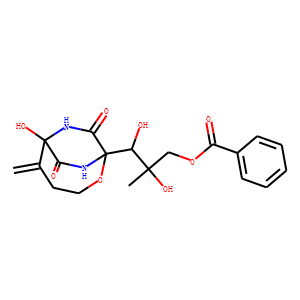| Reference | 1. Angew Chem Int Ed Engl. 2018 Jan 15;57(3):719-723. doi: 10.1002/anie.201710529. Epub 2017 Dec 12.<br />
A Six-Oxidase Cascade for Tandem C-H Bond Activation Revealed by Reconstitution of Bicyclomycin Biosynthesis.<br />
Meng S(1), Han W(1), Zhao J(1), Jian XH(1), Pan HX(1), Tang GL(1).<br />
Author information:<br />
(1)State Key Laboratory of Bio-organic and Natural Products Chemistry, Shanghai Institute of Organic Chemistry, University of Chinese Academy of Sciences, Chinese Academy of Sciences, 345 Lingling Road, Shanghai, 200032, China.<br />
As a commercial antibiotic, bicyclomycin (BCM) is currently the only known natural product targeting the transcription termination factor rho. It belongs to a family of highly functionalized diketopiperazine (DKP) alkaloids and bears a unique O-bridged bicyclo[4.2.2]piperazinedione ring system, a C1 triol, and terminal exo-methylene groups. We have identified and characterized the BCM biosynthetic pathway by heterologous biotransformations, in vitro biochemical assays, and one-pot enzymatic synthesis. A tRNA-dependent cyclodipeptide synthase guides the heterodimerization of leucine and isoleucine to afford the DKP precursor; subsequently, six redox enzymes, including five α-ketoglutarate/Fe2+ -dependent dioxygenases and one cytochrome P450 monooxygenase, regio- and stereoselectively install four hydroxy groups (primary, secondary, and two tertiary), an exo-methylene moiety, and a medium-sized bridged ring through the functionalization of eight unactivated C-H bonds.<br />
<br />
2. Biochemistry. 2018 Jan 9;57(1):61-65. doi: 10.1021/acs.biochem.7b00943. Epub 2017 Nov 7.<br />
Identification of the Biosynthetic Pathway for the Antibiotic Bicyclomycin.<br />
Patteson JB(1), Cai W(1), Johnson RA(1), Santa Maria KC(1), Li B(1).<br />
Author information:<br />
(1)Department of Chemistry, University of North Carolina at Chapel Hill , Chapel Hill, North Carolina 27599, United States.<br />
Diketopiperazines (DKPs) make up a large group of natural products with diverse structures and biological activities. Bicyclomycin is a broad-spectrum DKP antibiotic with unique structure and function: it contains a highly oxidized bicyclic [4.2.2] ring and is the only known selective inhibitor of the bacterial transcription termination factor, Rho. Here, we identify the biosynthetic gene cluster for bicyclomycin containing six iron-dependent oxidases. We demonstrate that the DKP core is made by a tRNA-dependent cyclodipeptide synthase, and hydroxylations on two unactivated sp3 carbons are performed by two mononuclear iron, α-ketoglutarate-dependent hydroxylases. Using bioinformatics, we also identify a homologous gene cluster prevalent in a human pathogen Pseudomonas aeruginosa. We detect bicyclomycin by overexpressing this gene cluster and establish P. aeruginosa as a new producer of bicyclomycin. Our work uncovers the biosynthetic pathway for bicyclomycin and sheds light on the intriguing oxidation chemistry that converts a simple DKP into a powerful antibiotic.<br />
<br />
3. Curr Drug Targets Infect Disord. 2005 Sep;5(3):273-95.<br />
The molecular basis for the mode of action of bicyclomycin.<br />
Kohn H(1), Widger W.<br />
Author information:<br />
(1)Division of Medicinal Chemistry and Natural Products, School of Pharmacy, University of North Carolina at Chapel Hill, Chapel Hill, NC 27599-7360, USA. [email protected]<br />
Bicyclomycin (1) is a clinically useful antibiotic exhibiting activity against a broad spectrum of Gram-negative bacteria and against the Gram-positive bacterium, Micrococcus luteus. Bicyclomycin has been used to treat diarrhea in humans and bacterial diarrhea in calves and pigs and is marketed by Fujisawa (Osaka, Japan) under the trade name Bicozamycin. The structure of 1 is unique among antibiotics, and our studies document that its mechanism of action is novel. Early mechanistic proposals suggested that 1 reacted with nucleophiles (e.g., a protein sulfhydryl group) necessary for the remodeling the peptidoglycan assembly within the bacterial cell wall. We, however, showed that 1 targeted the rho transcription termination factor in Escherichia coli. The rho protein is integral to the expression of many gene products in E. coli and other Gram-negative bacteria, and without rho the cell losses viability. Rho is a member of the RecA-type ATPase class of enzymes that use nucleotide contacts to couple oligonucleotide translocation to ATP hydrolysis. Bicyclomycin is the only known selective inhibitor of rho. In this article, we integrate the evidence obtained from bicyclomycin structure-activity studies, site-directed mutagenesis investigations, bicyclomycin affinity labels, and biochemical and biophysical measurements with recent X-ray crystallographic images of the bicyclomycin-rho complex to define the rho antibiotic binding site and to document the pathway for rho inhibition by 1. Together, the structural and functional studies demonstrate how 1, a modest rho inhibitor, can disrupt the rho molecular machinery thereby leading to a catastrophic effect caused by the untimely overproduction of proteins not normally expressed constitutively, thus leading to a toxic effect on the cells.<br />
<br />
4. Structure. 2005 Jan;13(1):99-109.<br />
Structural mechanism of inhibition of the Rho transcription termination factor by the antibiotic bicyclomycin.<br />
Skordalakes E(1), Brogan AP, Park BS, Kohn H, Berger JM.<br />
Author information:<br />
(1)Department of Molecular and Cell Biology, University of California, Berkeley, California 94720, USA.<br />
Rho is a hexameric RNA/DNA helicase/translocase that terminates transcription of select genes in bacteria. The naturally occurring antibiotic, bicyclomycin (BCM), acts as a noncompetitive inhibitor of ATP turnover to disrupt this process. We have determined three independent X-ray crystal structures of Rho complexed with BCM and two semisynthetic derivatives, 5a-(3-formylphenylsulfanyl)-dihydrobicyclomycin (FPDB) and 5a-formylbicyclomycin (FB) to 3.15, 3.05, and 3.15 A resolution, respectively. The structures show that BCM and its derivatives are nonnucleotide inhibitors that interact with Rho at a pocket adjacent to the ATP and RNA binding sites in the C-terminal half of the protein. BCM association prevents ATP turnover by an unexpected mechanism, occluding the binding of the nucleophilic water molecule required for ATP hydrolysis. Our data explain why only certain elements of BCM have been amenable to modification and serve as a template for the design of new inhibitors.<br />
|

